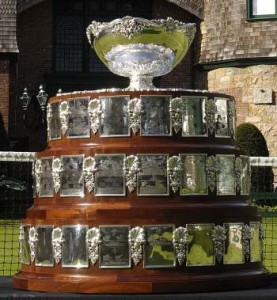Great Men of Tennis: Dwight Davis; Gerald Ford of the Tennis World 10
A new series for a new year. In a companion series to ‘Queens of the Court,’ ‘Great Men of Tennis’ takes a look at the men who have left an indelible mark on tennis. The series begins among the foundations of our modern game, with the man who invented aspects of the serve, and set the stage for Davis Cup competition: Dwight Davis.
In honor of Dwight Davis, this article is posted on the 110th anniversary of the first Davis Cup – held Feb 9, 1900.

The Davis Cup has been an important part of tennis history for 110 years.
Let’s see, Secretary of War? Or famous tennis star? Hmmm … Which career path to choose? How about both?!
Not many tennis stars go to college. John McEnroe, who is famously known for attending Stanford, really only attended the university for a single semester. John Isner, a current tennis star, is the only one in the top 50 to obtain a degree (at the University of Georgia) before starting his ATP career this year.
Like John Isner, Dwight Davis was a collegiate tennis singles champion. He played for Harvard University in 1899. The closest he came to a singles title was runner up in the US Championships in 1898. A lefty, Davis made a name for himself in doubles. While at Harvard he also went out for baseball and played on the sophomore football team.
Quite a few US politicians were collegiate, or even professional athletes, before embarking on a life of public service, among them: President Gerald R. Ford, and Senator Jack Kemp. Dwight Davis can be counted among these public figures. Davis would serve the U.S. as secretary of war from 1925-1929 under President Calvin Coolidge.
In spite of his dearth of singles titles, Davis serves as a keystone for our ‘Great Man of Tennis,’ because Davis, like Frenchman Rene LaCoste 30 years later, was not only a winner but also a technical innovator, and became a key mover and creator in the sport.
Like many tennis stars of his day, Davis was from an upper class family, one of the founding families in St. Louis Missouri. At the turn of the twentieth century, tennis was played in society clubs, and also in the street. To distinguish its form of tennis from that in the street, club tennis was known as ‘Lawn Tennis.’ An iconoclastic visual of the times comes from the musical ‘Ragtime,’ which depicts turn-of the century upper-class types in the opening vignette as ‘fellows with tennis balls’ in 1902, in New Rochelle New York; straw hats, slacks, afternoon tea, and a spot of tennis. Read the rest of this entry →



